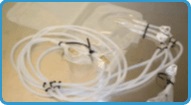

Discovery to Delivery
› Solutions ›Single Use Systems
Single-use components and systems, often called disposables, are typically made from plastic or elastomeric materials and are designed to replace metallic components in process operations. Single-use components are designed to be discarded after one use.
Many disposable systems are supplied to the user pre-cleaned and sterilized so item preparation before use is not necessary. This eliminates the need for cleaning and sterilization operations at the customer site. Sterilization of single-use systems is commonly performed by suppliers using gamma radiation, which is the same progress used for implantable medical devices. The single-use industry is to validate the manufacturing and sterilization systems according to medical device regulations. Alternative sterilization methods can include hydrogen peroxide, ethylene oxide, or autoclaving.
Common single-use process components
There are two primary factors for using single use systems in bioprocess operations. The first factor is the high capital and operating costs of specialized process equipment and facilities. Operation of stainless steel equipment is also expensive due to costs associated with cleaning, sterilization, validation, calibration and maintenance. Conversion to disposable equivalents often reduces overall operating costs.
The second factor is related to the increasing potency of biotech products. As product development technology and methods improve, product specificity to decrease state has increased. The diseases targeted, like cancer and autoimmune diseases, have become more critical.
Potent drug processing poses two problems. One is that the potent drugs are dangerous to operators and the environment, and therefore need to be contained. The second is that the potent drugs are difficult to remove from hard surfaces e.g., stainless steel.

Systems Used in Single- Used System/Materials
The typical filling equipment product is constructed primarily of 316 L stainless steel. Operation of these stainless system requires cleaning and sterilization operations prior to use. After use, the product path must be disassembled for offline cleaning and autoclaving of the product contact parts. System disassembly also increases the chance of leakage and subsequent product contamination when piping is misaligned or connections loosened. Online, automated CIP and sterilization in place (SIP) operations can be used to supplement or replace manual cleaning.
Disposable product path components are commonly used in filling operations. Tubing is used on the filling system product inlet line to the dosing system. It is also used to carry product between dosing pumps and filling needles. In fact, flexible tubing is required for systems in which the dosing pumps are stationary and the needles have movement. Filling needles can have significant vertical travel during bottom-up filling operations.
Tubing material for product application varies depending on the type of dosing system used. Flexible tubing materials such as silicone are commonly used on the outlet of positive displacement dosing systems like piston pumps and rolling diaphragm pumps. Silicone is also the most common tubing used for peristaltic pump dosing systems, where both flexibility and durability are required. Rigid tubing like Teflon® is used in time pressure dosing systems between the flow orifice (sometimes called a throttle valve) and filling needle. The relative volume change is great enough to affect the accuracy of product dosed in time pressure systems, particularly when the dose volumes are low.
Filling line equipment is commonly dedicated entirely to a single product because of cross contamination issues. Most filling lines today support multi-drug operations. Traditional multi drug operations. Traditional multi-drug operations require validation of the level of product carryover after cleaning operations to ensure subsequent products are not contaminated. Certain product-contact parts are hard to clean to acceptable levels, and are therefore dedicated to specific products.
An alternative to filling equipment dedication is the use of single-use parts and assemblies. These systems can include components like bulk product bags, capsule filters, silicone tubing, and other plastic fittings and parts. These parts can already be purchased pre-cleaned and pre-sterilized, and double or triple bagged for easy use within cleanrooms. Filling operations are critical enough to require entire single-use systems to be assembled and sterilized together rather than having to piece individual components together at the point of use. The dosing system used for filling also affects the characteristics of the single-use components.
Peristaltic dosing is ideally suited for disposables, as peristaltic tubing is used for much of the product path. Single-use peristaltic systems are typically comprised of a product hold bag, supply tubing and a filling needle that are bagged together and sterilized using gamma irradiation. The assembly is removed from the bag and connected to the filling system, which can be as simple as a single peristaltic pump, immediately before use. High quality peristaltic pumps can be very precise at dosing water-like solutions at slower speeds. However, accuracy is directly influenced by the tubing. The tubing that is located in the pump head changes shape over time as a result of wear, so accuracy drift is common. Characterizing and compensating for the drift is required. Peristaltic pumps also dose at slower speeds, which means that high speed peristaltic systems require more pump heads to dose at the same rate as the equivalent piston, time pressure or rolling diaphragm systems.
Gravimetric dosing uses optical sensors to dose a given volume based on a calculation of the interior volume of a given length of tubing or glass. The entire product calculation path is supplied as a single-use, pre-sterilized assembly. Accuracy and precision of the system with water-like solutions is comparable to other dosing systems.
The current single use, pre-sterilized dosing systems are based on scaling up technologies designed and used for small-scale filling operations. The three most common commercial systems are piston pumps, rolling diaphragm pumps, and time pressure dosing. All three of these systems would require significant technical improvements and modifications to be converted to disposable use.
Piston pumps rely on a precise physical tolerance between the pump body and piston to provide dosing accuracy and to ensure product does not leak during use. Pump bodies and pistons are commonly matched when they are fabricated to ensure they do not gall during use. Piston pumps that are exclusively used in pharmaceutical industry are made of stainless steel. Neither material can be used to make a disposable pump due to high cost of manufacture. Plastic components are an alternative, but cannot be fabricated to the correct tolerances to ensure accuracy.
The rolling diaphragm pump is comprised mostly of stainless steel pump with a diaphragm. Dosing occurs by actuating a piston that is attached to the diaphragm, hence it is the only part that keeps the product from the contact with the piston and other internal components.
Time pressure systems are designed to dispense using a pressurized product supply and timed valve openings. A portion of the product path from the product supply manifold to the filling nozzles is made of elastomeric tubing. This tubing is used in association with an automatic tubing pinch mechanism to create the valve.
A limitation to all current single-use pre-sterilized dosing systems is the plastic filling needle. The current plastic needles are not designed for commercial filling operations. Most are too wide to penetrate small containers and/or are too short to perform bottom up filling. Bottom up filling, where the filling needle penetrates the container opening and is drawn out during dosing, is common with high speed filling to reduce product splash and foaming. The plastic needles are also not shaped to fit correctly within needle holders on common commercial filling systems. Custom fixtures are required to use them on existing machines.
High speed filling requires needles made to very tight tolerances, particularly in diameter, as this has an influence on dosing accuracy and precision. As high speed needles travel during and after dispensing, needle drip between doses has to be eliminated. Precise needle opening size and opening shape is also required. Substituting plastic needles with ones made from stainless steel can solve most of these issues, but it is too expensive for single-use assemblies.
Sign up to our newsletter and receive the latest news and updates about our products!
